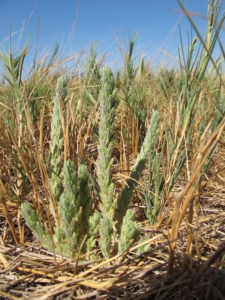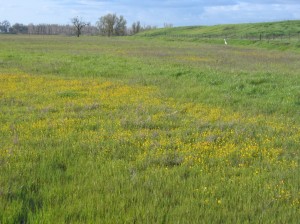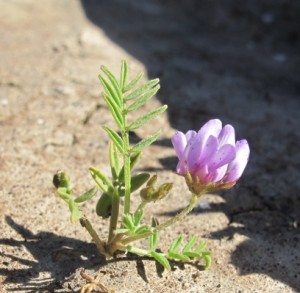


Area: 180 Acres
Location: Woodland, Yolo County, CA
Date Acquired: 2005
Acquisition Type: Alkali Grassland is owned by the City of Woodland and a portion is owned by private landowners. The Center for Natural Lands Management (CNLM) holds a conservation easement and has perpetual management responsibilities to protect imperiled species and habitats that exist on the Preserve.
Key Habitats: Alkali Grassland and Seasonal Wetlands, California Annual and Perennial Grassland.
Species of Special Interest to CNLM: Palmate-bracted bird’s beak(Chloropyron [Cordylanthus palmatus] palmatum), Alkali milkvetch(Astragalus tener var. tener) – California Native Plant Society, Brittlescale (Atriplex depressa), San Joaquin spearscale (Atriplex joaquiniana), Heckard’s peppergrass (Lepidium latipes var. heckardii), Pappose tarweed (Centromadia parryi ssp. rudis), Swainson’s Hawk and Burrowing Owl.
Introduction
The Alkali Grassland Preserve is approximately 180 acres of grassland and seasonal wetland habitats south of the City of Woodland in Yolo County, CA. The Preserve was set aside to fulfill the biological mitigation requirements for several projects in the Woodland area. The Preserve provided mitigation for project-related impacts to Swainson’s hawk (Buteo swainsonii), burrowing owl (Athene cunicularia), and alkali sink special-status plants.
The Preserve is comprised of three separate units: the Brauner Unit, the Maupin Unit, and the unit located within the southern portion of the City of Woodland’s wastewater treatment plant (WWTP), the WWTP Unit. The City of Woodland owns the Brauner and WWTP units; the Maupin Unit is under private ownership.
In December 2005, CNLM was granted conservation easements on all three units. In addition, a portion of the Maupin Unit (approximately 37 acres) was preserved under a U.S. Army Corps permit. The purpose of the conservation easements is to help ensure that the properties will be retained in perpetuity in open space condition and to prevent use of the properties that will impair or interfere with the conservation values of the Preserve. CNLM is responsible for the perpetual care of the Preserve, ensuring the habitat remains healthy for the imperiled species, meeting all conservation easement obligations.
Conservation Significance
The Preserve is composed of alkali grassland and seasonal wetlands that provide habitat for alkali wetland plant species. The grasslands are dominated by species such as alkali barley (Hordeum depressum), salt grass (Distichlis spicata), soft chess (Bromus hordeaceus), Italian ryegrass (Festuca perennis), common tarweed (Centromadia pungens), yellow rayed goldfields (Lasthenia glabrata ssp. glabrata), alkali heath (Frankenia salina), suada (Suaeda fruticosa), and Mediterranean barley (Hordeum marinum ssp. leporinum). Common plant species found within the alkali seasonal wetlands include salt grass, Mediterranean barley, annual hairgrass (Deschampsia danthonoides), alkali weed (Cressa truxillensis), and annual beard grass (Polypogon monspeliensis).
The Preserve supports a population of the state and federally endangered palmate-bracted bird’s-beak. California Native Plant Society (CNPS) List 1B species observed on the Preserve include alkali milkvetch (Astragalus tener var. tener), brittlescale (Atriplex depressa), Heckard’s peppergrass (Lepidium latipes var. heckardii), and San Joaquin spearscale (Atriplex joaquiniana). Pappose tarweed (CNPS List 4; Centromadia parryi ssp. rudis) has also been observed on the Preserve. The Preserve provides foraging habitat for the state threatened Swainson’s hawk and habitat for burrowing owls (a state and federal species of special concern). Swainson’s hawks are known to nest along Willow Slough, just south of the Preserve, and burrowing owls have been observed on the Preserve.
Our Work
The primary goals for the Preserve are to protect the conservation values of the Preserve which include improving and maintaining high quality habitat for Swainson’s hawk, burrowing owl, and alkali sink special-status plant species; protect special-status species populations on the Preserve; collaborate and partner with others who share our interest and vision in protecting these important imperiled species; distribute information to the public about the Preserve so they can learn and appreciate the value of the Preserve; increase the habitat quality of the Preserve by working with others for potential protection of an adjacent site in order to connect adjacent lands with similar resources; and to stabilize and improve palmate-bracted bird’s-beak populations on the Preserve.
Public Access
Due to the vulnerability of the species and habitats that exist on this preserve, it is not open to the public.
Contact
For information on Alkali Grasslands Preserve or Center for Natural Lands Management please contact Cathy Little, Regional Preserve Manager at clittle@cnlm.org or 760.731.7790 extension 209




